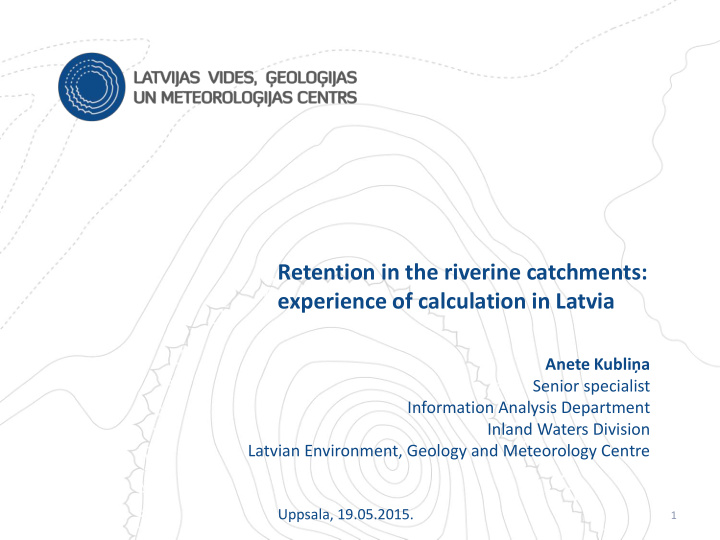



Retention in the riverine catchments: experience of calculation in Latvia Anete Kubliņa Senior specialist Information Analysis Department Inland Waters Division Latvian Environment, Geology and Meteorology Centre Uppsala, 19.05.2015. 1
« Chemical composition of surfaces waters of Latvia and its influencing factors » • Researches about calculation of retention in riverine catchments are not deeply developed in Latvia. • Dr. Ilga Kokorīte in her thesis «Chemical composition of surfaces waters of Latvia and its influencing factors» (2007) has slightly described theoretically this process and tried to assess retention volumes using a statistical model, but there turned out a variety of problems with the quality of data. • For calculation of loads nutrients, pollution sources and extents of retention there was used statistical MESAW model (Grimvall and Stålnacke, 1996). 2
« Chemical composition of surfaces waters of Latvia and its influencing factors » The main steps of calculation in MESAW model: • Calculation of average substances load, using monitoring data; • Dividing river basin in sub-basins, taking into account placement of monitoring stations; • Summarizing statistical data about sub-basins (land cover, lake area, loads from point sources or other); • Calculating of substances load from every sub-basin: n L R L R S R P R D ( 1 ) ( 1 ) ( 1 ) ( 1 ) , i i , j j l i 2 i 3 i i j 1 where L i – load from sub-basin i , in estuary (mouth), L j – load from upstream sub-basin j , R i,j – substance retention in sub-basin i, n – count of upstream sub-basins for sub-basin i , S i – substances load from diffuse sources in sub-basin i , P i – load from point sources in sub-basin i , D i – substances deposition from atmosphere in sub-basin i , R 1-3 – retention of pollution from sources S, P un D , 3 ε i – statistical error coefficient .
« Chemical composition of surfaces waters of Latvia and its influencing factors » Substance retention volumes in all river section till the river mouth is calculated with the formula: Where R, i mouth – substance retention volumes from sub-basin i till river mouth; K – count of sub-basins; R i – retention volumes in sub-basins below sub-basin i 4
« Chemical composition of surfaces waters of Latvia and its influencing factors » Results In the doctoral thesis of I.Kokorīte load assessment, using MESAW model, was used for 22 river sub-basins. Model estimated coefficient of nitrogen runoff from agricultural land t-criterion value is 3.5, while from the natural areas it is 3.4. The model estimated ratio of phosphorus runoff from agricultural areas t-criterion value is 1.64, but from natural areas that value is 1.38. There is low statistical significance level for phosphorus loads an retention volumes (p>0,05) (there was not taken into account in calculation soil type, granulometry of soils and topography of catchment basin). Retention of total phosphorus is 22% on average. Retention of total nitrogen is 18% on average. 5
Assessment of retention in PLC-5 report of LV Retention coefficient for total nitrogen and total phosphorus was calculated, using Behrnedt&Opitz (1998) formula N tot .: R SN =6.3((Q*86,4*0.365)/As) -0.78 P tot .: R SN =4,7((Q*86,4*0.365)/As) -0.76 As (area of surface waters in catchment basin) = As=Alake+0.001*A 1.185 (Alake (lake area in catchment basin) was calculated, using CORINE Land- cover data) Retention (for total nitrogen, total phosphorus) = R N,P = R SN, SP * L tot (measured load in river) Results show retention of ~50% on average for both N tot. and P tot. 6
Mass Balance Model (Version 8.0 - 30/06/2014) Data needed: • Total catchment area, km 2 • Mean runoff, mm/year Lake retention River retention 7
Thank you for attention! 8
Recommend
More recommend